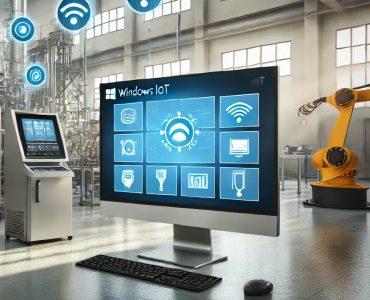
In today’s rapidly evolving world of industrial technology, choosing the right operating system for industrial computers is critical to optimizing production and operational processes. More and more companies are turning to Windows IoT (Internet of Things) as the preferred solution for powering industrial computers. In this article, we will explore in detail why Windows IoT is an excellent choice for industrial computers, comparing it to other operating systems and highlighting its many benefits and unique features.
1. What is Windows IoT?
Windows IoT, part of the Windows family of operating systems, is specifically designed for IoT (Internet of Things) devices and industrial computers. It is an optimized version of Windows that allows devices to run in environments with limited hardware resources while providing full access to advanced Windows features. Within this family of operating systems, there are key variants such as:
- Windows IoT Core – for simpler devices with lower hardware requirements.
- Windows IoT Enterprise – for advanced industrial devices and computers with full Windows functionality.
2. Why is Windows IoT the Best Choice for Industrial Computers?
2.1. Familiarity and Support from Microsoft
One of the most important reasons for choosing Windows IoT is that it’s a product of Microsoft, a global leader in software development. Industrial computers often require stable, secure, and easy-to-manage solutions, and Windows IoT delivers these, offering long-term technical support and regular security updates.
Microsoft is renowned for its extensive documentation and robust technical support, making it easier to migrate or deploy Windows IoT in an industrial environment compared to lesser-known or niche solutions. Moreover, many organizations already use Windows-based solutions, meaning their IT teams are familiar with the Microsoft ecosystem, making integration and management smoother.
2.2. Cloud Integration and Azure IoT
Windows IoT works seamlessly with Azure Cloud, enabling integration with advanced data analytics and device management tools. With cloud connectivity, real-time monitoring and remote management of industrial computers become possible. Azure IoT Hub allows smooth communication between IoT devices, which is crucial in modern, automated production environments.
Advanced Azure IoT analytical capabilities combined with Windows IoT allow for:
- Real-time data collection from industrial devices.
- Analysis of that data using AI and machine learning tools.
- Remote management and software updates on devices.
These capabilities are invaluable in the industrial sector, where uninterrupted machine operation is critical to maintaining production continuity and minimizing downtime.
2.3. Industrial-Level Security
Security in industrial environments is a top priority. Industrial computers are often responsible for controlling production processes, energy management systems, or logistics, meaning any breach in their security could lead to serious financial and operational consequences.
Windows IoT Enterprise offers advanced security mechanisms, including:
- BitLocker – an encryption tool that provides data protection on industrial devices.
- Secure Boot – technology that protects against unauthorized software running on the device.
- Windows Defender Advanced Threat Protection (ATP) – an advanced antivirus tool that monitors devices in real-time and guards against external threats.
All these features make Windows IoT much more resistant to cyberattacks compared to many other operating systems used in the industrial sector.
2.4. Flexibility and Scalability
Windows IoT offers tremendous flexibility in supporting a wide range of industrial devices. With support for various hardware, from simple sensors to advanced industrial computers, Windows IoT can handle both small and large enterprises requiring complex technological solutions.
Additionally, Microsoft customizes its products to the needs of industrial customers, offering the ability to tailor the user interface, add custom applications, and optimize the system for specific industries. This makes Windows IoT the ideal solution for both small manufacturing companies and global industrial giants.
2.5. Compatibility with Existing Solutions
Many industrial manufacturers already use Microsoft products such as Microsoft Office, Power BI, or ERP and CRM systems, which are tightly integrated with the Windows ecosystem. Thanks to Windows IoT, these same industrial devices can seamlessly work with the existing IT infrastructure, simplifying management, data integration, and process analysis.
Moreover, Windows IoT supports a wide range of communication protocols and standards, such as OPC UA, which is commonly used in industrial automation. This means that Windows IoT can easily integrate with machines, sensors, and other devices, regardless of their manufacturer.
2.6. Long-Term Support and Stability
Microsoft provides long-term support for its IoT products, which is crucial in industries where computers and devices must operate for many years without frequent updates. The Windows IoT Enterprise version offers long-term servicing channel (LTSC) support, meaning it can run stably for many years without the need for major changes, which is essential in critical production environments.
Thanks to its stability and long-term support, companies can rely on their devices running smoothly for years, minimizing maintenance costs and the risk of failures.
3. Comparing Windows IoT to Other Operating Systems
While Windows IoT has many advantages, it’s also worth looking at other available solutions and comparing them for industrial use.
3.1. Linux
Linux is often chosen in industrial environments due to its open-source nature, flexibility, and lack of licensing fees. However, its implementation in industry often requires extensive technical knowledge and IT specialist support. Linux is also not always as well integrated with existing systems and software used in the industry, especially those related to the Microsoft ecosystem.
For companies without a large IT team, managing Linux-based systems can be more complicated and costly, making Windows IoT a more appropriate solution for many industrial applications.
3.2. Android
Like Linux, Android is based on open-source code, making it flexible and customizable for various industrial uses. However, Android lacks some of the advanced security, integration, and enterprise-level features offered by Windows IoT, making it less suitable for critical industrial applications.



















